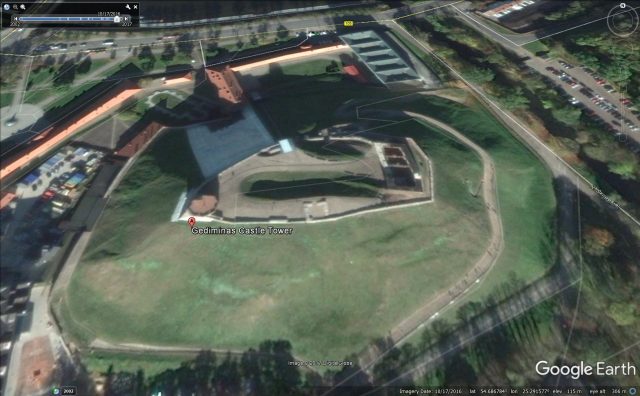27 June 2017
Gediminas Castle Hill: landslides at a historic site
Posted by Dave Petley
Gediminas Castle Hill: landslides at a historic site
Gediminas Castle Hill is a historic mound, 40 metres high, on which the Gediminas Tower is located in the city of Vilnius in Lithuania. This is a key historic site – Gediminas Tower is the remaining part of the Upper Castle, the origins of which date to 1409. The mound is natural, being formed of exceptionally weak glacial and lake deposits that have been extensively affected by solifluction, but it has been heavily modified by humans over the centuries.

Gediminas Castle Hill, via Wikipedia
.
The Lithuanian news site DELFI reports today (report behind a paywall, but Sina has the content) that the Lithuanian Government is planning to declare an emergency over the landslide problems on the hill. Some of these landslides are clearly visible in the image above – note the hummocky terrain and the tension cracks. On Google Earth these images are also clearly evident. This is an image from last month showing clearly instability on the north flank:-

Instability on the north flank of Gediminas Castle (image via Google Earth). North is at the top of the image.
.
Whilst this image from last year shows instability on the south flank as well. Note that works were ongoing on the north flank at this time:

2016 Google Earth image showing signs of instability on the south flank of Gediminas Castle Hill
.
The emergency has been declared in order to accelerate the mitigation of the landslide problems on the hill. Works have just started to deal with the landslides on the north flank, but the south flank needs urgent attention as well.
Interestingly, this is a site with a long history of landslides. According to Milkulėnas et al. (2017) a landslide from Gediminas Castle Hill in 1396 killed 15 people, and a major failure occurred in 1551, causing damage to the castle. They also document evidence of slope mitigation works carried out between the 14th and the 17th Centuries. More recently, the hill has suffered repeated episodes of landsliding, and there have a number of attempts to stabilise parts of the hill with both soft and hard geotechnical measures.
Managing instability at such a sensitive heritage site is a huge challenge, but the indications from the images above suggest that urgent interventions are needed. Of course this is not the only heritage site threatened by landslides – I have described other examples from Serbia and India for example.
Reference
Milkulėnas V., Minkevičius V., Satkūnas J. (2017) Gediminas’s Castle Hill (in Vilnius) Case: Slopes Failure Through Historical Times Until Present. In: Mikoš M., Vilímek V., Yin Y., Sassa K. (eds) Advancing Culture of Living with Landslides. WLF 2017. Springer, Cham (parts of this paper are available here).


 Dave Petley is the Vice-Chancellor of the University of Hull in the United Kingdom. His blog provides commentary and analysis of landslide events occurring worldwide, including the landslides themselves, latest research, and conferences and meetings.
Dave Petley is the Vice-Chancellor of the University of Hull in the United Kingdom. His blog provides commentary and analysis of landslide events occurring worldwide, including the landslides themselves, latest research, and conferences and meetings.
https://www.mdpi.com/2072-4292/13/14/2757/htm